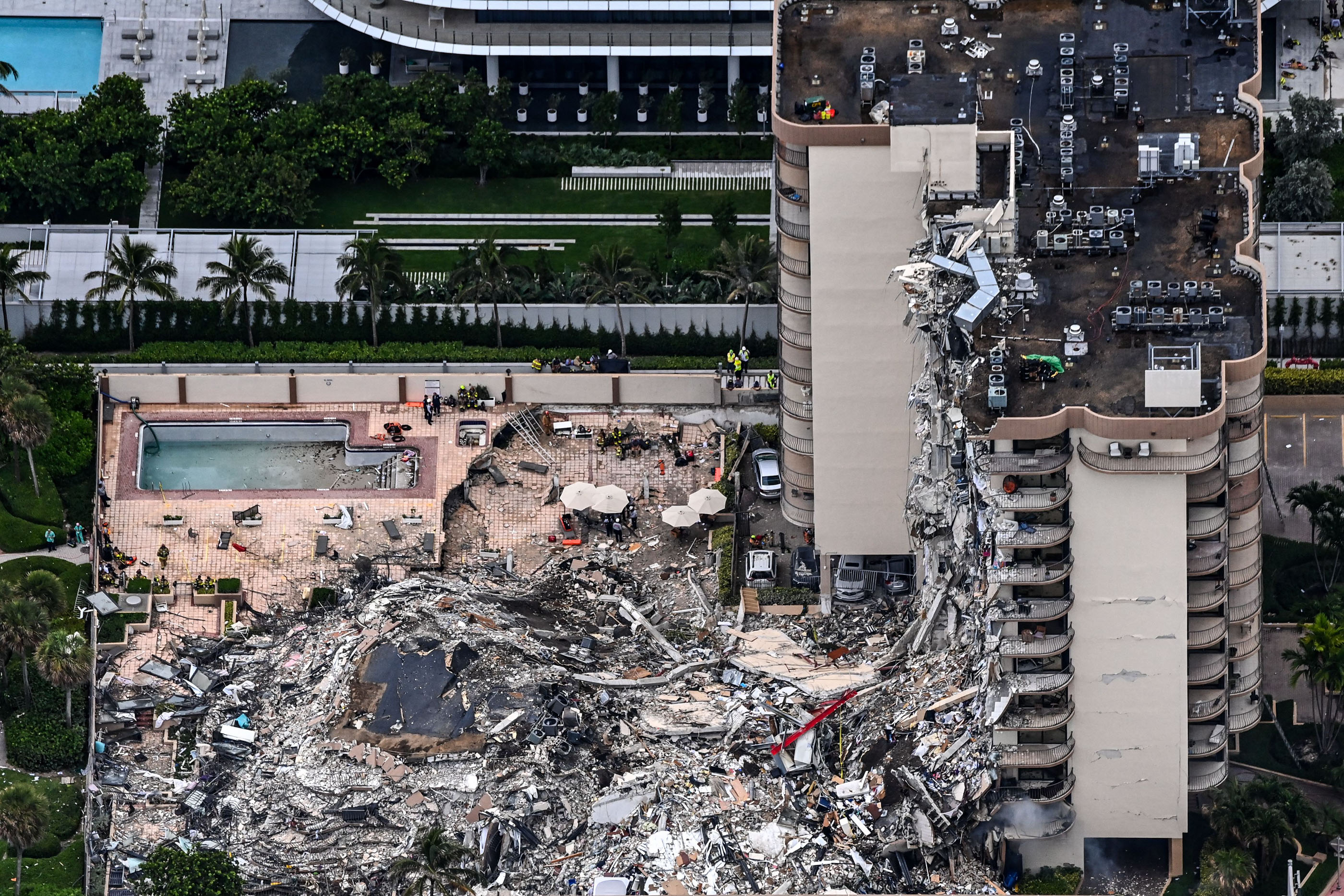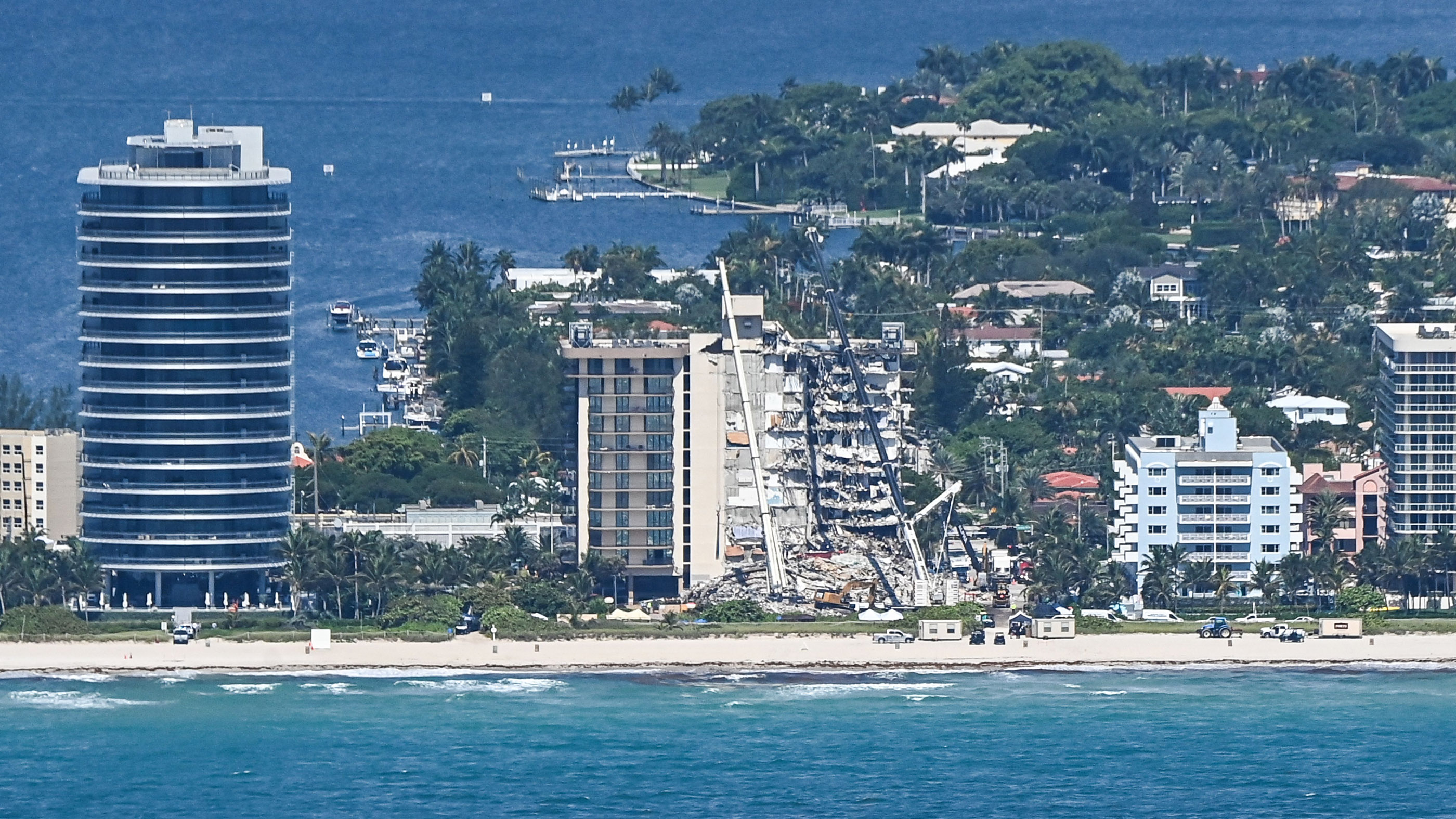What caused the Surfside condo collapse in Miami-Dade County?

Early Thursday (June 24) morning, part of a condominium complex in Surfside, Florida, suddenly collapsed. In about 11 seconds, 55 of the building's 136 units crumbled into a pile of rubble, and now, as the search for survivors continues, experts are investigating why the catastrophe happened in the first place, according to news reports. So far, structural damage, poor building design and sinking land beneath the condo have all been flagged as possible triggers for the disaster.
Allyn Kilsheimer, a veteran engineer who investigated the 1995 Oklahoma City federal building bombing and the 1993 World Trade Center bombing, will examine the foundation of the building and look for cracks, leaks and any intrusions of groundwater or saltwater, The Washington Post reported. He noted that building collapses are often caused by several factors that work together.
For instance, in October 2018, engineer Frank Morabito described various concerns about the Surfside condo, called the Champlain Towers South Condo, in a report that he'd prepared for the condo association, The Miami Herald reported. He noted that the building's pool deck and outdoor planters were not sloped to facilitate proper water drainage, which had led to "major structural damage" over time.
Related: Lessons From 10 of the worst engineering disasters in US history
This design flaw could be traced back to the original contract documents drawn for the building 40 years ago, Morabito wrote in the report.
Standing water on the pool deck had damaged the underlying concrete, and in particular, the parking garage beneath the pool deck showed signs of structural stress, in the form of "sizable" cracks and exposed rebar that was corroding in various locations. "Though some of this damage is minor, most of the concrete deterioration needs to be repaired in a timely fashion," Morabito wrote. "Failure to replace waterproofing in the near future will cause the extent of the concrete deterioration to expand exponentially."
Given the building's age, however, the reported damage was "fairly typical," Kenneth Direktor, an attorney for the building's condominium association, told The Washington Post. "Something horrible happened," Direktor said. "This isn't the result of hairline cracks in the concrete."
Get the world’s most fascinating discoveries delivered straight to your inbox.
The 2018 report didn't signal that the building could be in danger of collapse, and in general, experts aren't yet sure that concrete deterioration and corrosion were the sole triggers behind the structural failure, The New York Times reported.
However, videos of Thursday's disaster "would suggest a foundation-related matter — potentially corrosion or other damage at a lower level," Donald Dusenberry, a consulting engineer, told the Times. One resident also reported seeing some sort of hole open up near the pool just before the partial collapse, which supports the idea that the collapse began underground, the Times reported. On a call with her husband Michael, condo resident Cassie Stratton mentioned that she could see the hole from her fourth-floor unit before the call abruptly cut off.
"You certainly can't rule out a design or construction error that has survived for 40 years," although again, it is not yet certain whether the water-related corrosion caused the collapse, Dusenberry said.
Beyond corrosion, the building could have been compromised by poor design, substandard building materials or improperly installed pipes, the Times reported. Heavy construction also took place near the building in 2019, and a condo board member had reached out to the city citing "concerns regarding the structure of our building," due to the associated ground shaking; the city did not intervene in the matter.
Another explanation for the collapse is that a void or a sinkhole opened up under the reinforced concrete pilings that sit beneath the building, causing some pilings to shift downward while others remained in place, David Peraza, a structural engineer at Exponent, an engineering and scientific consulting firm, told the times. "Whether there's something geologically under the building that caused this, that's definitely something that's got to be investigated," he said.
In that vein, a 2020 study, published in the journal Ocean & Coastal Management, suggested that the land beneath Champlain Towers South has been gradually sinking since the 1990s through a process called "subsidence." Subsidence occurs when large amounts of groundwater get drawn out of the sediment and no longer help prop up the land above, according to the U.S. Geological Survey; subsidence is usually caused by human activities, such as draining underground reservoirs to prepare land for development.
The town of Surfside sits on a barrier island in the Atlantic Ocean, separated from mainland Miami by Biscayne Bay; according to space-based radar data, the island experienced subsidence at the rate of about 0.04 to 0.1 inches (1 to 3 millimeters) per year between 1993 and 1999, although that sinking was not evenly distributed across the entire landmass, the researchers reported in the 2020 paper. Most pockets of subsidence appeared on the western side of the island, where buildings were constructed on reclaimed wetlands, but some pockets also appeared on the eastern side, where Surfside is located.
"This was unusual, the pocket we saw in Surfside," as that side of the island is known to be more stable than the western side, senior author Shimon Wdowinski, and Florida International University (FIU) professor, said in a statement.
"The western part of Miami Beach was built on reclaimed wetlands and has been subjected to more subsidence," Wdowinski told Live Science in an email. "The eastern side of the city is built on higher ground overlying limestone and is less likely to experience subsidence." The rate of subsidence under Surfside was about 0.08 inches (2 mm) per year, "which is relatively low, but still above the detection level," he said.
The observed rate of subsidence is fairly low compared with places like Mexico City, which is subsiding at a rate of roughly 15 inches (38 centimeters) per year, according to the FIU statement, although a 2021 study suggests an even faster rate of 20 inches (50 cm) per year, according to Eos Magazine.
That said, the small changes like those in Surfside accumulate over time and can amount to several inches of sinking over the course of decades, Wdowinski noted.
However, based on earlier studies by Wdowinski and his colleagues, "in most cases, these buildings just move … there's no catastrophic collapse like in the case here in Surfside, which was very unfortunate," he said. In other words, it's unlikely that the subsidence alone caused the structure to fail. In theory, the deep-set pilings beneath the condo would have provided stability despite the gradual sinking, so other factors are likely to blame, Peraza told the Times.
Originally published on Live Science.

Nicoletta Lanese is the health channel editor at Live Science and was previously a news editor and staff writer at the site. She holds a graduate certificate in science communication from UC Santa Cruz and degrees in neuroscience and dance from the University of Florida. Her work has appeared in The Scientist, Science News, the Mercury News, Mongabay and Stanford Medicine Magazine, among other outlets. Based in NYC, she also remains heavily involved in dance and performs in local choreographers' work.



